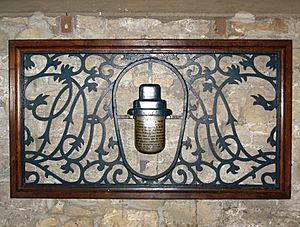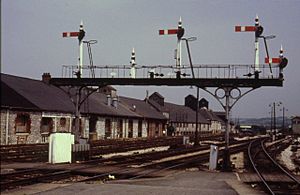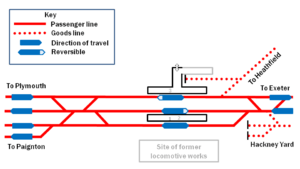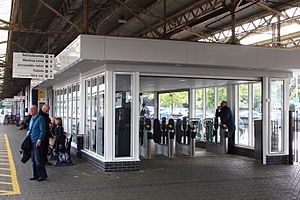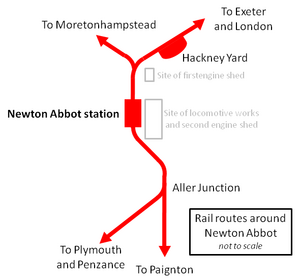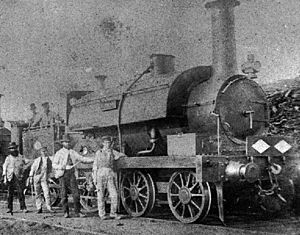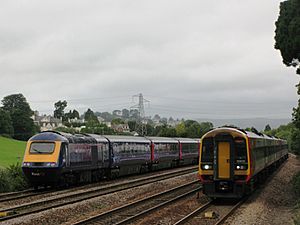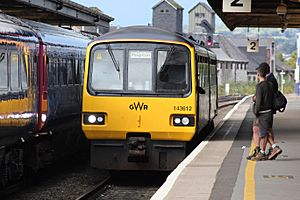Newton Abbot railway station facts for kids
Quick facts for kids
|
|
|---|---|
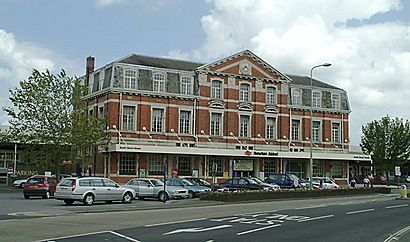
The station building of 1927 by Percy Emerson Culverhouse
|
|
| Location | Newton Abbot, Teignbridge England |
| Coordinates | 50°31′48″N 3°35′59″W / 50.5300°N 3.5997°W |
| Platforms | 3 |
| Other information | |
| Station code | NTA |
| Classification | DfT category C1 |
| History | |
| Original company | South Devon Railway |
| Pre-grouping | Great Western Railway |
| Post-grouping | Great Western Railway |
| Key dates | |
| 1846 | Station opened |
| 1848 | Torquay branch opened |
| 1866 | Moretonhampstead line opened |
| 1927 | Station rebuilt |
| 1940 | Station bombed |
| 1959 | Moretonhampstead line closed |
| 1987 | Station resignalled |
| Traffic | |
| Passengers (2015/16) | |
| Passengers (2016/17) | |
| Passengers (2017/18) | |
| Passengers (2018/19) | |
| Passengers (2019/20) | |
Newton Abbot railway station is in the town of Newton Abbot in Devon, England. It's about 20 miles (32 km) from Exeter St Davids and 214 miles (344 km) from London Paddington. This station is also a junction for the train line that goes to Paignton.
Today, Great Western Railway manages the station. They also provide train services along with CrossCountry. For many years, Newton Abbot was also a junction for trains going to Moretonhampstead. It was also home to a big locomotive workshop.
Contents
History of Newton Abbot Station
When Did the Station Open?
The station was first opened by the South Devon Railway Company on December 30, 1846. This happened when their train line was extended from Teignmouth railway station. The line then reached Totnes on June 20, 1847. A branch line to Torquay was added on December 18, 1848. Later, the Moretonhampstead and South Devon Railway opened its branch line on June 26, 1866. All these early railways used a special wide track called the 7 ft (2,134 mm) broad gauge.
When people first came to the station from Queen Street, they would see a large goods shed. On the other side of the tracks was a pumping house. This house was part of an atmospheric railway system that powered trains for a short time. The passenger station was south of these buildings. It first had two, then three, small train sheds. These covered separate platforms for trains going to Exeter, Plymouth, and Torquay. In 1861, the station was rebuilt into one larger station with a single train shed covering all three platforms.
On February 1, 1876, the South Devon Railway joined with the Moretonhampstead company. Then, they both became part of the Great Western Railway. The station was first called just "Newton". But on March 1, 1877, its name was changed to "Newton Abbot".
The very last broad gauge train ran on May 20, 1892. After this, all the train lines in the area were changed to the 4 ft 8 1⁄2 in (1,435 mm) standard gauge over one weekend. The workshops at Newton Abbot helped change broad gauge locomotives, carriages, and wagons to standard gauge in the months that followed.
| Preceding station | Disused railways | Following station | ||
|---|---|---|---|---|
| Teignmouth | Great Western Railway – South Devon main line | Totnes | ||
| Great Western Railway – Torquay branch | Kingskerswell | |||
| Teigngrace Halt | Great Western Railway – Moretonhampstead branch | Terminus | ||
Building a New Station
Plans to rebuild the station with four platforms were made, but World War I caused delays. The facilities for goods trains were moved to the Moretonhampstead branch line on June 12, 1911. Some extra tracks, called sidings, were built at Hackney on December 17, 1911. These changes made way for the station to grow after the war.
The rebuilt station was officially opened on April 11, 1927. It was designed by Percy Emerson Culverhouse, the Chief Architect of the Great Western Railway. The new station building now faced the town along Queen Street.
An old broad gauge locomotive, Tiny, was put on display at the station. This was to show a link to the station's past.
The platform for southbound trains had to be rebuilt again. This happened after an air raid on August 20, 1940, during World War II. Six bombs were dropped, and 14 people sadly died.
The Moretonhampstead line stopped carrying passengers on February 28, 1959. Goods trains were cut back to Bovey railway station from April 6, 1964. From July 6, 1970, they ran no further than Heathfield. The last regular trains on this line ran in 1996.
What's New at the Station?
The last trains used the old Platform 4 on April 24, 1987. Removing this platform allowed a flat entrance from the road. It also made space for a bigger car park. The loop lines, which let fast trains pass the station without stopping, were also removed. New signals were put in over the next week. The station was fully working again from May 5, 1987. Now, everything is controlled from a signal box in Exeter. A new junction was added for the Paignton branch line. The signals now let trains run in both directions on each track.
Some of the old signalling equipment was moved to the Newton Abbot Town and GWR Museum. There, it's part of a display that shows how the railway helped shape the town. Around this time, the old locomotive Tiny was also moved. It went from the station platform to Buckfastleigh railway station. It is now displayed in the museum of the South Devon Railway Trust.
The remaining part of the Moretonhampstead line stopped being used in 2009. Temporary blocks were placed on the line about 0.6 miles (1 km) from Newton Abbot. However, the line to Heathfield has since reopened. In 2012, it started seeing daily timber trains going to Chirk in Wales.
South West Trains used to run services between London Waterloo and Plymouth or Paignton until December 2009. They then stopped services west of Exeter.
For many years, the station was "open" without staffed ticket gates. But in August 2017, new ticket barriers were put in. They are now in a new building on the platform.
Station Masters Through the Years
- George Gardener/Gardner 1863 - ????
- F.J. Pratt ???? - 1878
- Henry Maggs 1878 - 1895
- H.B. Williams 1895 - 1900
- J.B. Mayers 1900 - 1906
- C.E. Needs 1906 - 1920
- Herbert J. Haly 1920 - 1935
- John Henry Johnson 1935 - 1946
What the Station Looks Like Today
The main entrance to Newton Abbot station is on the west side. It faces Courtenay Park and Queen Street, which leads to the town centre. You enter through South Devon House, the building opened in 1927. There are a few steps up to the platform from here. However, there's also a step-free path from the taxi rank on the south side of the building. The car park is next to this, where the old Platform 4 used to be. At the north end of this platform, there was once a terminal platform and sidings next to Tucker's Maltings. These used to serve the Moretonhampstead branch.
After being an "open station" for many years, new ticket barriers were put in during August 2017.
Today, only three tracks are used for passenger trains. The platform closest to the entrance (Platform 3) is used by most trains going beyond Exeter to London, northern England, and Scotland. A wide footbridge, with both stairs and lifts, leads to the southbound platform. The track on the west side (Platform 2) is mostly for trains going to Plymouth and Penzance. The east side (Platform 1) is mainly for trains going to and from Paignton.
Trains from Paignton can use either side of the station. Long-distance trains usually switch to the main line south of the station. This means they use the same platform as trains from Plymouth. Local trains to Exeter and Exmouth often run the "wrong way" through the same platform they use when going to Paignton. Then, they join the main line north of the station. Also, trains to Paignton often use the Plymouth platform if another train is blocking the usual Paignton platform.
The industrial area across from the station was where the South Devon Railway workshops were. Their engine shed was a little north of the station. Beyond this was Hackney marshalling yard. Here, goods trains were, and sometimes still are, reorganized for their journey over the hills towards Plymouth.
Places Near the Station
What is Hackney Yard?
Located at 50°32′14″N 3°35′32″W / 50.5372°N 3.5921°W
A new marshalling yard was opened at Hackney, just north of the station, on December 17, 1911. It's a useful place for freight trains traveling over the steep hills of Dartmoor towards Plymouth. These trains often need to be shorter or use extra locomotives because of the difficult route.
The sidings (extra tracks) were closed to regular traffic on January 10, 1971. They have now been updated, but there are fewer sidings than before. They were used for unloading stone in the 1990s. Now, they regularly see cement trains going to Moorswater on the Looe branch in Cornwall. These trains are split into two parts here. One part is left while the Freightliner locomotive takes the first section forward. It then returns later for the rest of the wagons. The sidings are also used to park railway engineers' vehicles. In 2012, a new Network Rail Recycling Depot opened here. This means engineers' trains regularly bring sections of rail to the yard to be cut and sold.
The Old Engine Shed and Workshops
Located at 50°31′48″N 3°35′52″W / 50.5301°N 3.5979°W
The first engine shed was built north of the station, across from Tucker's Maltings. A workshop for the railway's locomotive contractors was also set up here. Over the years, it grew to include places for maintaining carriages and wagons. An old 0-4-0 locomotive, Tiny, was put in the workshops to power the machines. When it was no longer needed for this, it was fixed up and put on display at the station. It has since moved to the railway museum at Buckfastleigh. It is the only original British 7 ft (2,134 mm) broad gauge locomotive that still exists.
The original engine shed closed in 1893. A new, larger shed was built in 1926. It had eight tracks and was designed for heavy maintenance. The workshops had special equipment to lift and repair all types of Great Western Railway locomotives. The last steam engine to be repaired here was number 4566, on July 15, 1966. Some steam engines from the private Dart Valley Railway were also repaired here after it closed to British Rail work.
To the west, the site also had a six-track workshop for carriages and wagons. This was used for maintaining and repairing all types of rolling stock (train cars). Cleaning was done on tracks between the station and the locomotive sheds.
After the railway decided to use diesel trains, the site was completely rebuilt in 1962. This was to make space for diesel engines, like the Warship Class trains. The workshops were changed to have four tracks with service pits and platforms at cab level. This allowed them to repair eight locomotives at once. A daily service and fueling point was built next to the old steam shed. This became the main facility after the factory closed in 1970.
Diesel multiple units (DMUs) were serviced in another shed next to the carriage cleaning tracks. This shed was later used to repair the electric heating and air conditioning on newer Mark 3 and Mark 4 coaches.
The diesel repair sheds closed in 1970. However, a place for servicing and fueling locomotives and coaches stayed until 1981. Then, servicing moved to Laira Traction Maintenance Depot. An industrial estate now stands on the site. Two of the old workshop buildings were still there in the 21st Century. But one caught fire on October 29, 2018. Five boys were later arrested on suspicion of starting the fire.
What is Aller Junction?
Located at 50°30′54″N 3°35′19″W / 50.5149°N 3.5887°W
The branch line to Torquay originally left the main line near the station. It ran next to the Plymouth line for about 1 mile (1.6 km). Then, the Plymouth line turned into the hills at Aller. A proper junction, called Torquay Junction, was put here on January 29, 1855. This was because the two single lines became part of the double-track line from Newton to Totnes.
In 1874, the branch line was extended to the station again. It ran next to the Plymouth line, just like before 1855. There were now three tracks in this section. On May 22, 1876, the branch line was doubled as far as Kingskerswell, adding a fourth track. The tracks were (from east to west) down branch, up branch, down main, up main.
In 1914, plans were made to add a "flying junction" at Aller. This would help trains coming off the branch line go faster. But World War I stopped these plans. On May 24, 1925, a junction was again put where the two lines split. This was now called Aller Junction. The four tracks were now grouped by direction of travel: down relief, down main, up relief, up main. Trains for either line could use either track between the junction and the station. However, trains to and from the branch usually used the "relief" lines. This meant trains coming off the branch had to cross over the line used by trains going towards Plymouth. This could cause delays when it was busy. The junction was moved in 1987 to a new spot about 0.5 miles (0.8 km) closer to the station. Now, trains can run to and from the branch on a single line connection with their own platform. Or, they can cross over to the Plymouth–Exeter tracks on either side of the station if it's easier.
A private siding was opened on the Torquay branch in 1866. It was used for sand from a nearby pit. It was removed in 1964.
Train Services at Newton Abbot
From the south, trains from two different companies meet at Newton Abbot. They come from Penzance and Plymouth on the main line. They also come from Paignton on the Riviera Line.
Great Western Railway runs the main line service to London Paddington station. They also run local trains to Exeter and Exmouth. Their London services include the overnight Night Riviera and the daytime Cornish Riviera Express to Penzance. They also have the midday Torbay Express to Paignton.
CrossCountry operates trains that go through Birmingham. These trains go to Manchester, the north east of England (Leeds and Newcastle), and Scotland (Glasgow Central, Dundee & Aberdeen).
| Preceding station | Following station | |||
|---|---|---|---|---|
| Teignmouth | Great Western Railway Exeter to Plymouth Line |
Totnes | ||
| Great Western Railway Riviera Line |
Torre | |||
| Teignmouth | CrossCountry Scotland to Plymouth |
Totnes | ||
| CrossCountry Paignton to Birmingham New Street via Bristol Temple Meads |
Torquay | |||
See also
 In Spanish: Estación de Newton Abbot para niños
In Spanish: Estación de Newton Abbot para niños


